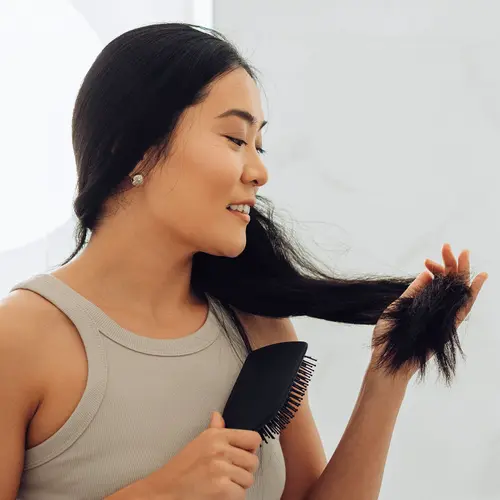You love your wavy hair, but the frizzy fly-aways you get when you brush those curls? Not so much.
Hair is complex. It's made up of three layers and thousands of cells. But the reason it gets frizzy is pretty simple. Your hair's outer layer, the cuticle, looks kind of like a shingled roof, dermatologist Carolyn Jacob, MD, says. When hair is smooth, those shingles lie flat. But when you run a brush through dry, curly hair, those “shingles” lift.
To compound the problem, stylist Dennis Baker, owner of Atlanta’s Baker Lanier Salon and Day Spa says, frizzy hair is often drier and naturally tends to absorb moisture from humid air. Again, those “shingles” lift.
Frizzy Hair: 12 Quick Tips to Keep Hair Frizz-Free
1. Don't brush dry hair. If there's one tip repeated by just about every expert, it's this: avoid brushing hair after it dries. Brushing not only disrupts your hair's cuticle, it can also stretch hair, leading to breakage.
Instead, stylist Connie Eeyerlin of Dionysius Salon in Eugene, Ore., says, towel-dry hair after a shower and brush, comb, or finger-comb it. Next, add a touch of your preferred conditioner or anti-frizz product and just say no to styling with brush or comb.
2. Comb dry hair with wet fingers. If you shouldn't brush, what can you do when humidity or a brisk day leaves your hair a frizzy mess? Water is the key, Eeyerlin says. "The problem with frizzy hair is that it's dry. Water is a basic response to this basic problem." Eeyerlin suggests wetting your hands, then finger-combing to tackle frizz and tame tangles.
3. Tame with a touch of conditioner. To foil her frizz, California archivist Kimber Camacho favors watering down a bit of hair conditioner and then using her hands to apply it to just the tips of her hair.
4. Look for protein in your conditioner, dermatologist Jacob suggests. A protein-infused conditioner will both manage frizz and create shine.
5. Don't over-process hair. Relaxers and straighteners can make hair brittle and lead to breakage, Jacob says, so go easy on these products.
6. Put moisture back in your mane. Frizzy hair tends to be drier, so you need to put moisture into it. Use a conditioner, a natural oil, or a frizz cream, Baker says. He says natural oils are better than synthetic because they are absorbed into the hair. Synthetic silicon moisturizers, on the other hand, lie on top of the hair, making it appear dirty.
7. Stop 'cooking' your curls. "Anything that would blister your skin doesn’t work so great on your hair either," writes Teri LaFlesh, author of Curly Like Me. LaFlesh suggests avoiding flat irons and curling irons and limiting heat sources to a blow dryer with a diffuser.
8. Use a round brush to smooth your hair. Spin a round brush through your hair as you blow dry to help smooth the cuticles flat, Baker says.
9. Dry only the roots of your hair. Eeyerlin suggests blow drying only your roots to give hair lift and avoid drying the hair shaft and hair tips.
10. Go alcohol-free. Alcohol can dry hair out, setting you up for frizz. So look for alcohol-free products. That may mean switching to salon-quality shampoos, conditioners, and hairsprays, Eeyerlin says. "Salon-quality products don't have to last as long on the shelf, so they don't contain as many harsh ingredients -- like alcohol -- as supermarket and drugstore products do."
11. Fight afternoon frizz by smoothing hair with a small amount of children’s detangling spray. Marie Gains, a North Carolina caretaker, says, "I spray a smidge of it in my hand and then smooth it down. It's very lightweight and doesn't make your hair look oily."
12. Talk to your stylist. "If what you're using works, use it," Eeyerlin says, whether it's a pricey product or a great drugstore find. But remember that your stylist probably has a host of hints that'll help keep you frizz-free from morning to night.


